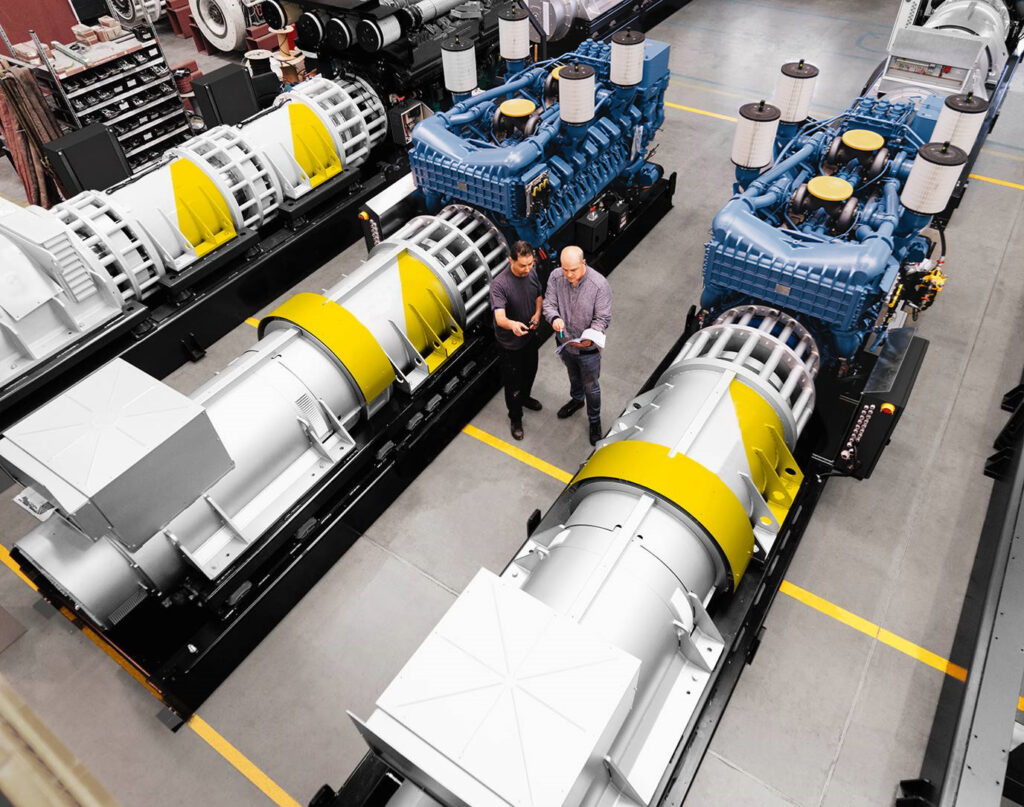
Critical Power
1. Uninterruptible Power Supplies (UPS):
In any critical infrastructure the need to maintain operation of equipment is paramount to avoid data loss, business interruption and other consequences. Typically we install UPS systems in most data center facilities, government sectors, healthcare, finance, education, oil & gas, commercial & hospitality sectors to ensure a continuous supply of power irrespective of the availability of utility power. Our wide range of UPS systems starts from 700VA through to 1600KVA.

2. Diesel Generator
Diesel generating sets are used in places without connection to a power grid, or as emergency power-supply if the grid fails, as well as for more complex applications such as peak-lopping, grid support and export to the power grid. DCPS provides full range starting from 3kVA – 3000kVA for below application:
- Infrastructure
- Residential & Commercial
- Industrial Gensets
- Marine Gensets
- Light Towers
- Rental Gensets

3. Diesel Rotary UPS
Diesel rotary uninterruptible power supply devices (DRUPS) combine the functionality of a battery-powered or flywheel-powered UPS and a diesel generator. When mains electricity supply is within specification, an electrical generator with a mass functions as motor to store kinetic energy in an electro-mechanical flywheel. When mains electricity supply fails, stored energy in the flywheel is released to drive the electrical generator, which continues to supply power without interruption. At the same time (or with some delay, for example 2 to 11 seconds, to prevent the diesel engine from starting at every incident), the diesel engine takes over from the flywheel to drive the electrical generator to make the electricity required. The electro-magnetic flywheel can continue to support the diesel generator in order to keep a stable output frequency. Typically a DRUPS will have enough fuel to power the load for days or even weeks in the event of failure of the mains electricity supply.
The main advantages of DRUPS equipment compared to battery-powered UPS combined with a diesel-generator are the higher overall system energy efficiency, smaller footprint, use of fewer components, longer technical lifetime (no use of power electronics) and the fact it does not result in chemical waste (no use of batteries).

4. Power Distribution Units (PDU)
The main purpose of a PDU is to supply AC power to multiple IT equipment pieces within the rack system. Distribute power simply with a basic power strip with no internal intelligence or boost it up with a more advanced model including outlet level power monitoring to remotely monitor, control, and report the status of every outlet within the unit. Offered in many sizes, colors, and configurations, rack PDUs can be customized to meet the demands involving: voltage, current, number and type of connections, remote access, and monitoring functionality. Rack mountable PDUs are available in these five main conventional designs, with an additional subset for even more precise control:
Provide power to the IT equipment without any advanced features such as metering or monitoring. They are widely available, easy to use and have a lower cost.
Typically include the feature sets of metered products in a single unit but also has the ability to remotely (IP) monitor the state of the distribution unit.
Typically include the feature sets of metered products in a single unit but also has the ability to remotely (IP) monitor the state of the distribution unit.
Provides unprecedented reliable and granular visibility into power consumption, coupled with remote/network power, and environmental monitoring.

5. Automatic Transfer Switch
Automatic Transfer Switches are critical components of any emergency or standby power system needing to maintain up-time. These switches automatically sense power loss and seamlessly switch to a back-up circuit. An ATS can provide fast (load transfers within 8 to 15 ms) and reliable load transfers from one power source to another. These types of switches are reliable, compact rack units for transferring essential loads and electrical distribution systems. The ideal environments include cloud computing infrastructures and data center racks filled with one-power-supply devices and adds an additional piece of automation in an increasingly automated data center.

6. Remote Monitoring
Smart Remote Monitor has been specifically designed to provide detailed information of the running UPS over a long distance, which is suitable to be used in data center, IDC, monitor and control room and other applications. The Smart Remote Monitor displays and monitors the parameters and status of the UPS in real time, ensuring the safe running of the UPS system

7. VRLA & Li-ion Batteries
Valve regulated lead acid (VRLA) batteries are the most widely used battery type because of their high power density and ease of use. A vented battery can give off sixty times more gas than a VRLA battery in normal use. The term VRLA derives from the use of safety valves that allow pressure to be released when a fault condition causes internal gas to build up faster than it can be recombined. VRLA batteries can be mounted on open racks (rarely), or in cabinets (most common). Small power systems (such as single-phase UPS systems) integrate VRLA batteries inside their own enclosures. VRLA batteries can use the ventilation provided for human occupancy. We offer full range starting from 7AH – 3000AH for different applications.

